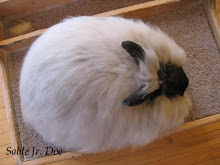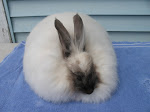--another post from the old blog
I was just flipping the 'Rabbit Production' book today and found some interesting facts on Wool growth, Molting, and adjusting feed to manipulate holding time. This is a wonderful book that encompasses ALL aspects of rabbit raising, and I find new information every time I read it:). Here are a few angora notes:
-"Females produce about 20% more wool than males"--p.441
-"Angoras reach their peak of wool production between 18 and 36 months of age. After three years of age, wool production and reproduction abilities begin a rapid decline."--p.441
-"There is an apparent antagonism between the amount of wool produced and reproductive performance"--P.441
-"Genetic selection is very important in the improvement of wool density and texture. Wool production and quality are highly heritable traits."--p.441
-"The rabbit's coat is prime when the hairs have a good sheen, are tight, and have attained their maximum length. The skin is white and the hair flows back into place evenly when the coat is rubbed from the rump to the shoulders".--p.105
-"Unprimeness is indicated by a dull, uneven coat and loose hair. The hair does not flow evenly when the coat is rubbed from the rump to the shoulders. Patches of new fibers can be seen, and these new fibers will appear in a growth pattern that varies from animal to animal. The skin of these new hair growth areas is dark and easily detected on rabbits with colored coats."--p.105
-"Heavy feeding of the young tends to cause the molt at an earlier age----Rabbits may be thrown into molt by disease, going "off feed", the sudden occurrence of unseasonable high temperatures, or other stresses."--p.106
-"Shedding first occurs on the sides of the rump and the thighs, followed by the back, then increasingly in areas down over the sides."--p.106
-"A high quality diet and high feed intake promote molting. The growth rate of hair is more rapid with a high nutrient intake, so the rate of turnover of hair is greater."--p.106
-"Restricted feeding of adult show animals reduces the amount of hair shedding and keeps the fur in prime condition for a longer period."--p.106
Basically I think that these facts demonstrate what so many good conditioners of rabbits already know----you cannot feed the same rabbit in exactly the same way year round regardless of climate or coat condition. An excellent breeder I know begins adding a top dressing to his meat rabbits' pellet ration as soon as a molt is over. He continues feeding this mix until JUST BEFORE the rabbits hit prime, and then pulls them off it and gives them nothing but pellets and a pinch of horse sweet feed while they finish building and completely prime out. The withdrawal of the grain mix at this point ensures that the growing cycle slows down and the rabbit holds prime condition longer, and the addition of sweet feed (only) makes the rabbits thirstier and improves flesh condition by increasing their fluid intake. Once a molt begins, he feeds the rabbits black oil sunflower seed to push them through it faster, and then begins the process over again once molts are finished and the new coats begin. This same formula may also work with angoras, though the sunflower seeds may not be necessary because we can clip our rabbits and get rid of the excess wool that way.
With our pellet rations, we also need to increase the amount of feed given in winter, restrict it in summer, increase when the coat is coming in, and decrease when the coat peaks and begins to go out (OR increase again when the coat slips in order to get it through the molt faster---I will be trying both those ideas in my herd to see if there is any difference in molt "speed" if you push the energy up).
Have a great week!
Monday, August 30, 2010
Subscribe to:
Post Comments (Atom)























No comments:
Post a Comment